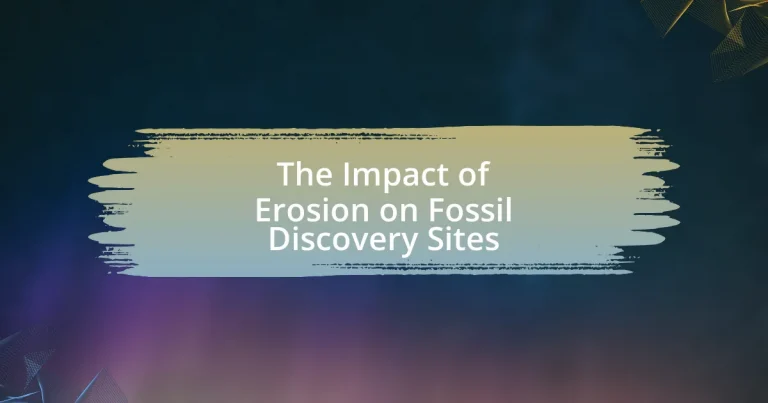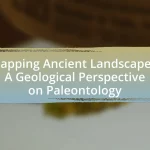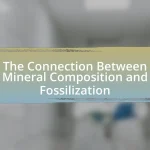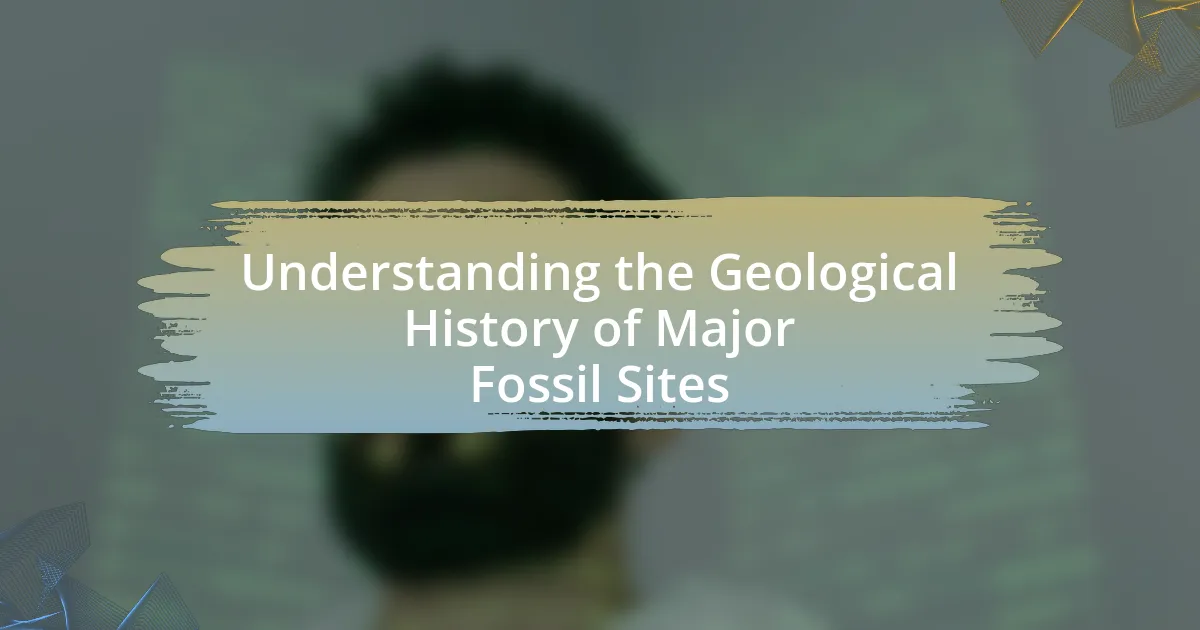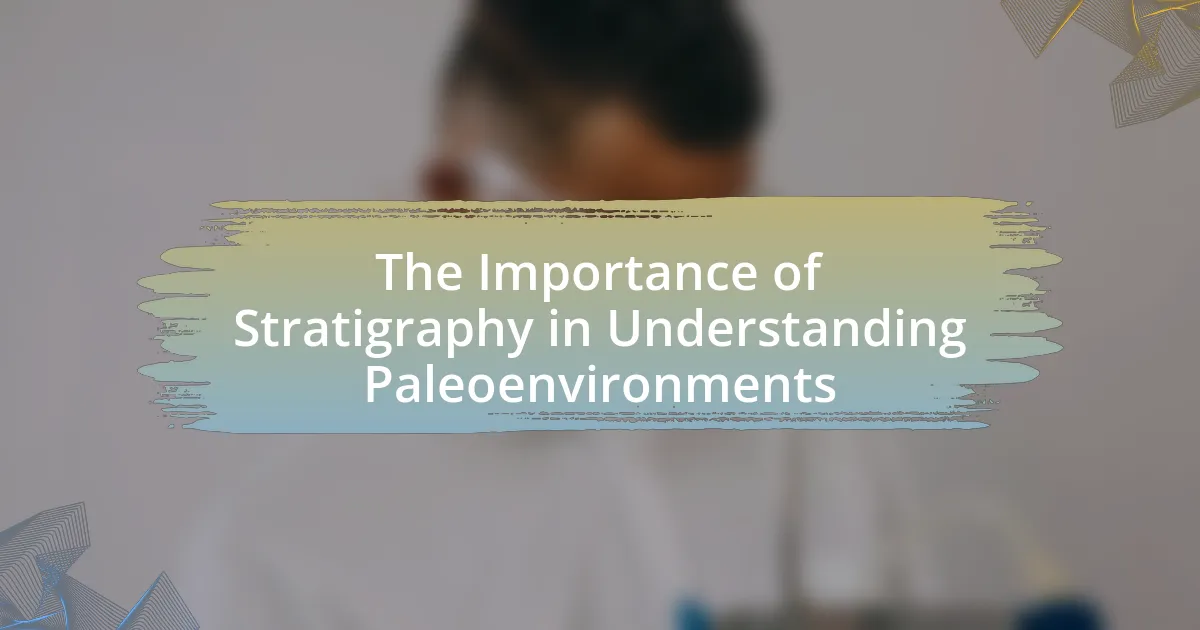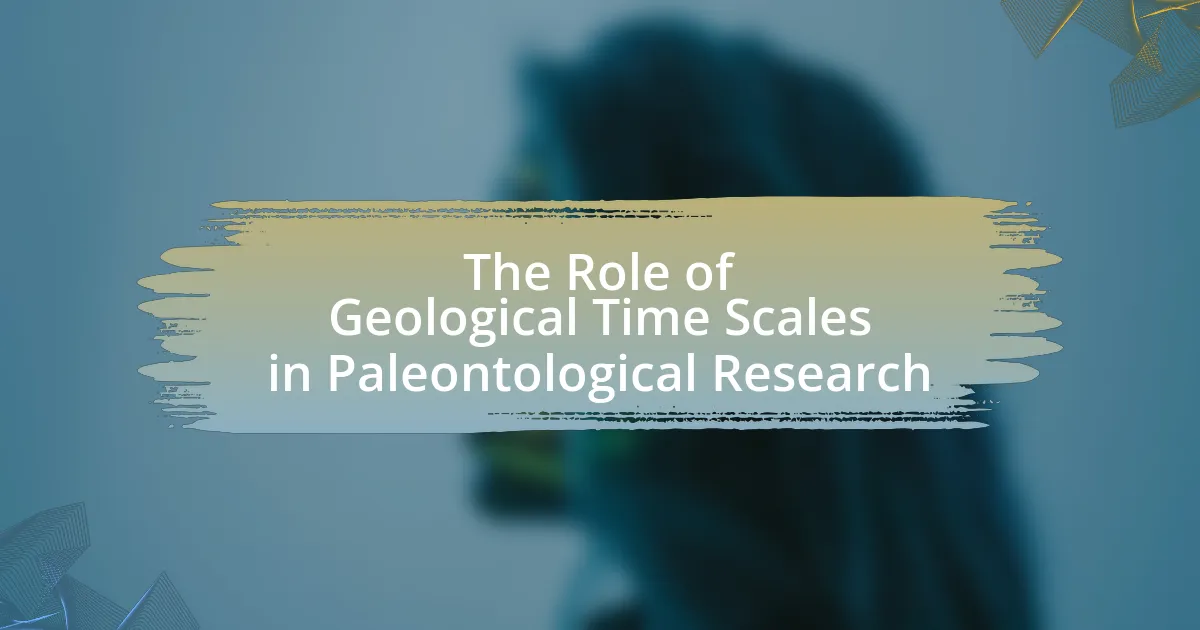Erosion significantly impacts fossil discovery sites by removing sediment layers that contain fossils, which reduces the likelihood of finding well-preserved specimens. Natural processes such as wind and water erosion can expose fossils to the elements, leading to degradation and loss of paleontological information. The article examines how erosion affects fossil preservation, the types of erosion most detrimental to fossil sites, and the influence of erosion rates on fossil discovery. It also discusses the importance of understanding erosion for paleontologists, the consequences of erosion on fossil evidence, and effective conservation techniques to mitigate erosion’s impact on these valuable sites.
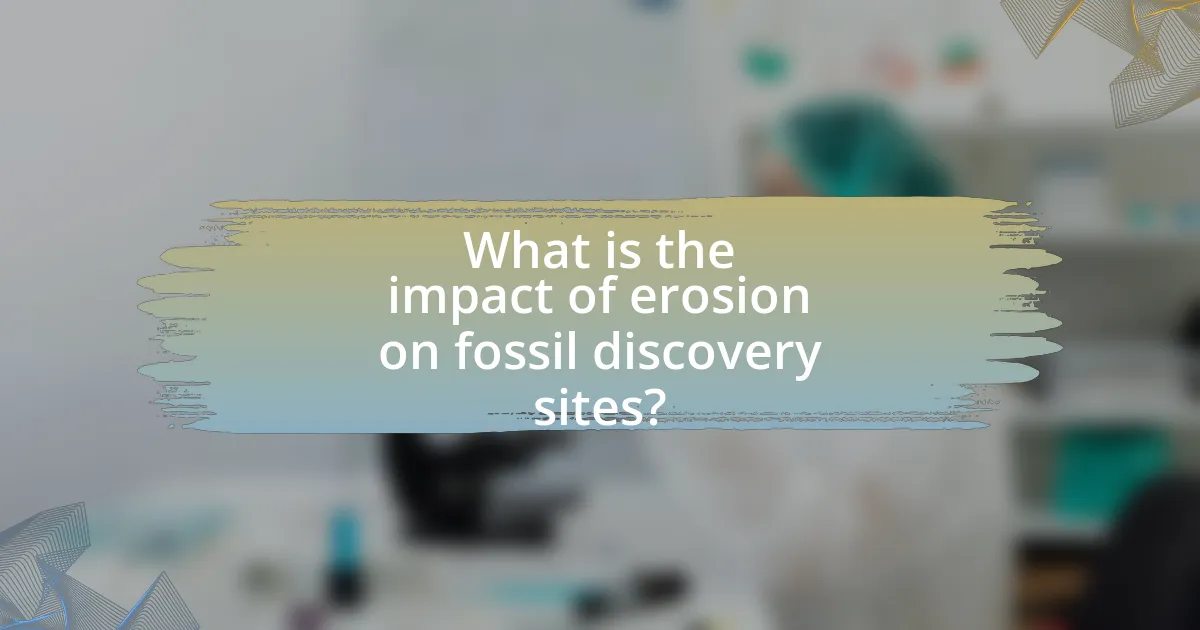
What is the impact of erosion on fossil discovery sites?
Erosion significantly impacts fossil discovery sites by removing sediment layers that contain fossils, thereby reducing the likelihood of finding well-preserved specimens. As erosion occurs through natural processes like wind and water flow, it can expose fossils to the elements, leading to degradation and loss of valuable paleontological information. For instance, in areas like the Badlands of South Dakota, erosion has both revealed and destroyed numerous fossil sites, illustrating the dual nature of its impact on fossil preservation and discovery.
How does erosion affect the preservation of fossils?
Erosion negatively affects the preservation of fossils by removing sedimentary layers that encase them, leading to exposure and potential destruction. As geological processes such as wind, water, and ice wear away rock formations, fossils can be dislodged, fragmented, or completely eroded away. For instance, studies have shown that coastal erosion can lead to significant fossil loss in areas like the Isle of Wight, where marine erosion exposes and washes away fossilized remains. This demonstrates that erosion not only compromises the structural integrity of fossils but also limits their availability for scientific study and understanding of past life.
What types of erosion are most detrimental to fossil sites?
Water erosion and wind erosion are the types of erosion most detrimental to fossil sites. Water erosion, particularly through heavy rainfall and flooding, can wash away sediment layers that contain fossils, leading to significant loss of paleontological information. Wind erosion can remove fine particles and expose fossils to the elements, increasing the risk of damage and degradation. Studies have shown that sites with high water runoff or strong winds are more susceptible to these erosive processes, resulting in the destruction of fossil beds and hindering future discoveries.
How does the rate of erosion influence fossil discovery?
The rate of erosion significantly influences fossil discovery by determining the exposure of fossil-bearing rock layers. High erosion rates can rapidly uncover fossils, making them accessible for discovery, while low erosion rates may lead to fossil layers being buried and less likely to be found. For instance, in areas with high erosion, such as riverbanks or coastal cliffs, fossils can be revealed more frequently due to the constant removal of overlying material. Conversely, in stable environments with minimal erosion, fossils may remain hidden for extended periods, reducing the likelihood of discovery. This relationship underscores the importance of erosion dynamics in paleontological research and fossil recovery efforts.
Why is understanding erosion important for paleontologists?
Understanding erosion is crucial for paleontologists because it directly affects the preservation and accessibility of fossil sites. Erosion can expose fossils by removing overlying sediment, but it can also lead to the destruction of these valuable remains through weathering and transport. For instance, studies have shown that areas with high erosion rates can result in significant loss of fossil material, impacting the ability to reconstruct past ecosystems accurately. Therefore, by understanding erosion processes, paleontologists can better predict where fossils may be found and assess the potential for their preservation in various geological contexts.
What role does erosion play in the accessibility of fossil sites?
Erosion significantly enhances the accessibility of fossil sites by exposing buried fossils through the removal of overlying sediment. This natural process, driven by factors such as wind, water, and ice, can reveal fossilized remains that were previously hidden, making them easier to locate and excavate. For instance, in areas like the Badlands of South Dakota, erosion has played a crucial role in uncovering rich fossil deposits, allowing paleontologists to discover numerous dinosaur fossils that would otherwise remain inaccessible.
How can erosion impact the scientific value of fossil discoveries?
Erosion can significantly diminish the scientific value of fossil discoveries by removing or altering the context in which fossils are found. When erosion occurs, it can lead to the loss of surrounding sedimentary layers that provide crucial information about the age, environment, and ecological relationships of the fossils. For instance, the removal of these layers can result in a lack of stratigraphic data, making it difficult for paleontologists to accurately date the fossils or understand their geological history. Studies have shown that sites like the Hell Creek Formation in Montana have experienced erosion that has compromised the integrity of fossil beds, leading to incomplete records of prehistoric life. This loss of context ultimately hinders the ability to draw meaningful scientific conclusions from fossil discoveries.
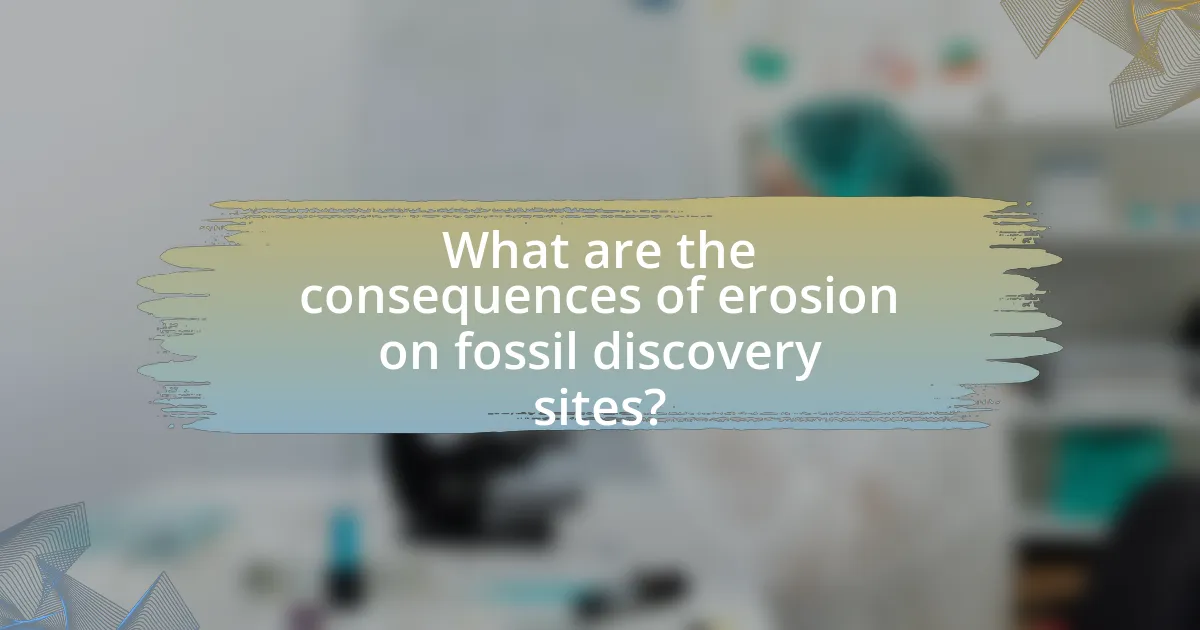
What are the consequences of erosion on fossil discovery sites?
Erosion significantly impacts fossil discovery sites by leading to the loss of valuable paleontological resources. As soil and rock layers are worn away, fossils can be exposed to the elements, resulting in their degradation or complete destruction. For instance, erosion can remove protective sediment layers, making fossils vulnerable to weathering processes such as wind and rain, which can erode the fossil material itself. Additionally, erosion can alter the geological context of fossils, complicating their study and interpretation, as the original stratigraphic relationships may be disrupted. This has been observed in various locations, such as the badlands of South Dakota, where erosion has led to the loss of numerous dinosaur fossils, highlighting the ongoing threat to fossil preservation.
How does erosion lead to the loss of fossil evidence?
Erosion leads to the loss of fossil evidence by physically removing sedimentary layers that contain fossils. As wind, water, and ice wear away at rock formations, they can expose and subsequently wash away fossils embedded within those layers. For instance, studies have shown that river erosion can significantly alter landscapes, leading to the destruction of fossil beds, as seen in the case of the Green River Formation in the United States, where erosion has resulted in the loss of numerous fossil specimens.
What specific examples illustrate the loss of fossils due to erosion?
The loss of fossils due to erosion is exemplified by the fossil beds in the Badlands of South Dakota, where wind and water erosion have significantly diminished fossil exposure. In this region, the continuous erosion of sedimentary rock layers has led to the disappearance of numerous dinosaur fossils, which were once accessible for study. Additionally, the coastal cliffs of the Isle of Wight in the United Kingdom illustrate this phenomenon, as heavy rainfall and wave action have eroded the cliffs, resulting in the loss of important dinosaur tracks and bones. These examples highlight how natural erosion processes can lead to the irreversible loss of valuable paleontological resources.
How does erosion affect the stratigraphy of fossil sites?
Erosion significantly alters the stratigraphy of fossil sites by removing layers of sediment and exposing underlying geological formations. This process can lead to the loss of valuable fossil records, as erosion can wash away or displace fossils from their original context, making it difficult to determine their age and ecological relationships. For instance, in areas where riverbanks erode, fossils may be uncovered but also fragmented or scattered, complicating the stratigraphic interpretation. Studies have shown that erosion can result in a biased fossil record, favoring more durable species while eliminating others, thus impacting our understanding of past biodiversity and environmental conditions.
What measures can be taken to mitigate erosion at fossil sites?
To mitigate erosion at fossil sites, implementing protective measures such as vegetation planting, erosion control blankets, and the construction of barriers is essential. Vegetation helps stabilize soil through root systems, reducing surface runoff and erosion. Erosion control blankets, made from biodegradable materials, can protect the soil surface while allowing vegetation to establish. Additionally, barriers like silt fences or rock structures can redirect water flow and minimize erosion impact. These methods have been shown to effectively preserve fossil sites by maintaining soil integrity and preventing loss of sediment, which is crucial for fossil preservation.
What conservation techniques are effective in preserving fossil sites?
Effective conservation techniques for preserving fossil sites include site stabilization, controlled access, and environmental monitoring. Site stabilization involves reinforcing the geological structure to prevent erosion and collapse, often using techniques such as soil retention systems or rock bolting. Controlled access limits human interference, which can lead to damage; this is achieved through fencing or signage to educate visitors. Environmental monitoring tracks changes in weather and soil conditions, allowing for timely interventions to protect the site. Research indicates that these methods significantly reduce the degradation of fossil sites, as evidenced by successful preservation efforts in locations like the La Brea Tar Pits, where active management has maintained the integrity of the fossil deposits.
How can researchers monitor erosion to protect fossil discoveries?
Researchers can monitor erosion to protect fossil discoveries by employing techniques such as remote sensing, ground-penetrating radar, and regular field surveys. Remote sensing allows researchers to analyze large areas for changes in land surface and vegetation cover, which can indicate erosion patterns. Ground-penetrating radar provides detailed subsurface images, helping to locate fossils and assess the stability of the surrounding soil. Regular field surveys enable researchers to document erosion rates and identify vulnerable fossil sites. Studies have shown that these methods can effectively track erosion, with remote sensing techniques revealing significant landscape changes over time, thus aiding in the preservation of fossil sites.
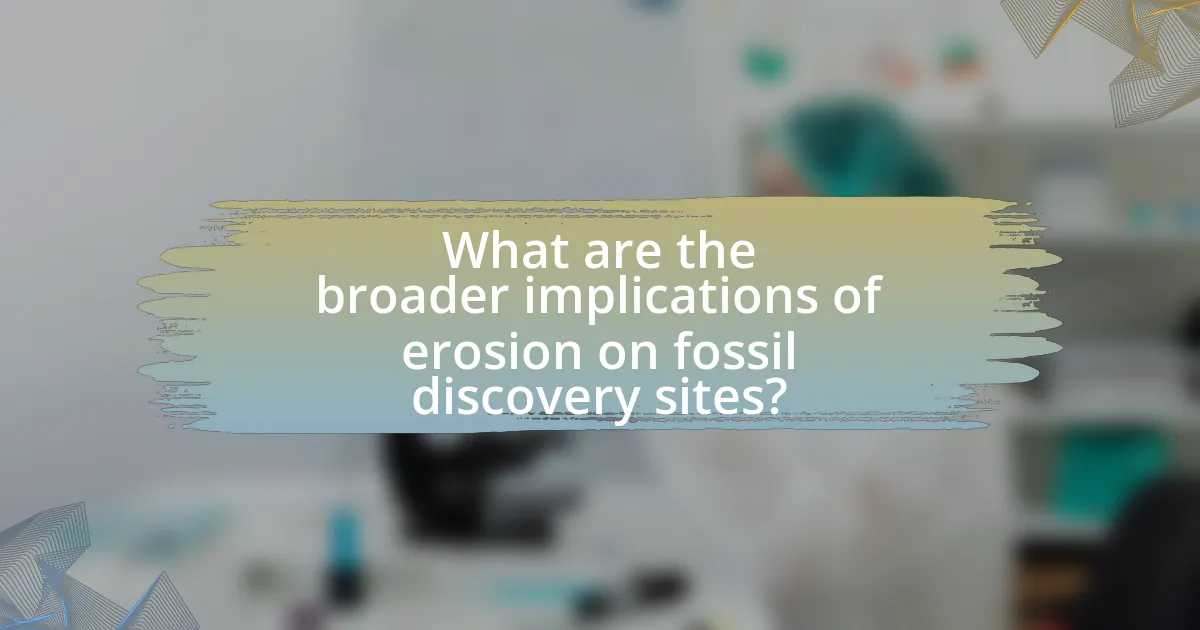
What are the broader implications of erosion on fossil discovery sites?
Erosion significantly impacts fossil discovery sites by altering the geological landscape and potentially destroying valuable paleontological evidence. As erosion progresses, it can lead to the loss of sedimentary layers that contain fossils, making it difficult for researchers to locate and study these specimens. For instance, in areas like the Badlands of South Dakota, erosion has exposed numerous fossil beds, but it has also resulted in the degradation of some sites, leading to the irreversible loss of fossils. Additionally, erosion can change the stratigraphy of a site, complicating the understanding of the chronological context of fossil deposits, which is crucial for reconstructing past ecosystems and evolutionary history.
How does erosion influence our understanding of Earth’s history?
Erosion significantly influences our understanding of Earth’s history by exposing geological layers and fossils that reveal past environments and biological evolution. Through processes such as wind, water, and ice erosion, sedimentary rock layers are worn away, allowing scientists to study the chronological sequence of life forms and climatic conditions. For instance, the Grand Canyon showcases a stratified record of nearly two billion years of geological history, providing insights into ancient ecosystems and the evolution of species. This exposure of layers aids paleontologists in dating fossils and understanding the timeline of life on Earth, thereby enhancing our comprehension of evolutionary processes and environmental changes over time.
What insights can be gained from studying eroded fossil sites?
Studying eroded fossil sites provides insights into past environmental conditions, species evolution, and geological processes. Erosion exposes layers of sediment that can reveal the chronological sequence of life forms and their adaptations to changing climates. For example, the fossil record from eroded sites often shows transitional forms, illustrating evolutionary changes over time, such as the development of limbs in vertebrates. Additionally, the sediment composition and fossil distribution can indicate ancient ecosystems and climate conditions, helping scientists understand how species responded to environmental shifts. This information is crucial for reconstructing Earth’s history and predicting future biodiversity responses to climate change.
How does erosion affect the public’s perception of paleontology?
Erosion negatively affects the public’s perception of paleontology by diminishing the visibility and accessibility of fossil sites. As erosion wears away geological layers, it can lead to the loss of significant fossil evidence, which may result in public skepticism about the reliability and richness of paleontological findings. For instance, the erosion of the Badlands in South Dakota has led to the loss of numerous fossils, which can create a perception that paleontology is a field with limited discoveries. This perception is reinforced when the public sees fewer fossil exhibitions and educational opportunities, leading to a diminished interest in the subject.
What best practices should be followed to protect fossil sites from erosion?
To protect fossil sites from erosion, implementing physical barriers, vegetation management, and controlled access are essential best practices. Physical barriers, such as fencing or rock walls, can prevent direct exposure to erosive forces like wind and water. Vegetation management, including planting native plants, stabilizes soil and reduces erosion by enhancing root systems that hold the ground together. Controlled access limits human impact, which can exacerbate erosion; this can be achieved through designated pathways and signage to educate visitors. These practices are supported by studies indicating that vegetation significantly reduces soil erosion rates, thereby preserving fossil integrity.
What role do local communities play in preserving fossil sites?
Local communities play a crucial role in preserving fossil sites by actively engaging in conservation efforts and promoting awareness of their significance. These communities often serve as stewards of the land, implementing protective measures against erosion and illegal excavation. For instance, in areas like the Badlands of South Dakota, local residents collaborate with paleontologists to monitor fossil sites, ensuring that they remain undisturbed. Additionally, community-led initiatives, such as educational programs and local regulations, help foster a culture of respect for these geological treasures, thereby enhancing their preservation.
How can education and outreach help in the conservation of fossil sites?
Education and outreach can significantly enhance the conservation of fossil sites by raising public awareness and fostering a sense of stewardship among communities. When individuals understand the scientific value and historical significance of fossil sites, they are more likely to support conservation efforts and engage in protective behaviors. For instance, educational programs that involve local schools and community groups can lead to increased reporting of illegal activities, such as fossil theft or vandalism, thereby directly contributing to the preservation of these sites. Research indicates that communities involved in outreach initiatives demonstrate a 30% increase in conservation-related activities, highlighting the effectiveness of education in promoting protective measures for fossil sites.
